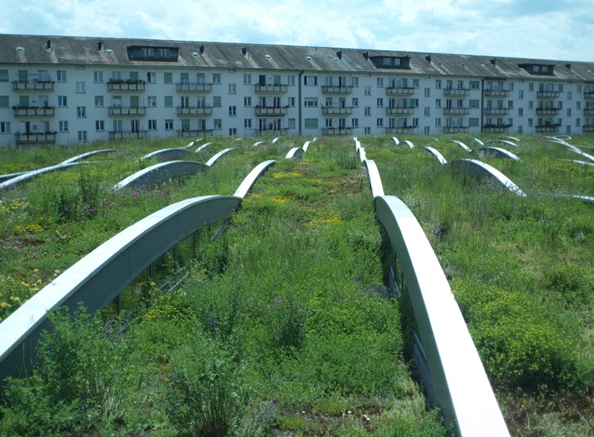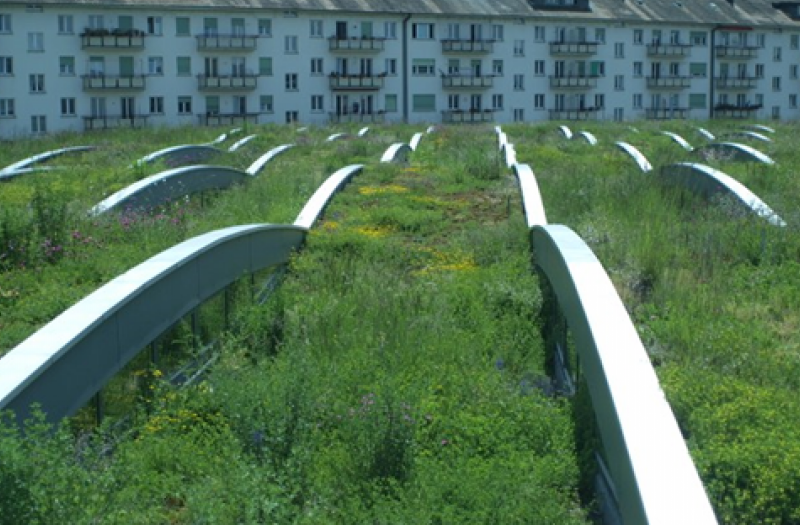Basel, Switzerland: Green roofs : Combining mitigation and adaptation on measures

By 2100, under a high greenhouse emissions scenario, the temperature is projected to increase by about 4.5 ºC in comparison to the 1990s. This means that every second summer will be as hot or even hotter than the temperatures reached during the 2003 heat wave which caused severe loss of life across Europe. Extreme precipitation events are likely to increase in frequency and severity. Green roofs were found to offer opportunities to combine energy saving, climate change mitigation and adaptation, and biodiversity objectives. In densely built-up areas where providing extensive parks and planting trees may be impossible, vegetated roofs are a feasible greening option. These roofs not only mitigate the urban heat island effect but also act as insulators. By minimizing heat gains in buildings, they can lower the indoor temperatures by as much as 5°C and consequently reduce the need for cooling and the associated energy use, thus contributing to climate change mitigation and adaptation. Modelling studies conducted in Manchester, UK show that greening all the suitable roofs in densely built-up areas could reduce storm water runoff by 17–20%. Green roofs can also provide ‘stepping stones’ for migratory species under changing climate conditions. The main aim of the green roof initiative is to increase the coverage of green roofs in the city of Basel through the use of a combination of financial incentives and building regulations.
By 2100, under a high greenhouse emissions scenario, the temperature is projected to increase by about 4.5 ºC in comparison to the 1990s. This means that every second summer will be as hot or even hotter than the temperatures reached during the 2003 heat wave which caused severe loss of life across Europe. Extreme precipitation events are likely to increase in frequency and severity. Green roofs were found to offer opportunities to combine energy saving, climate change mitigation and adaptation, and biodiversity objectives. In densely built-up areas where providing extensive parks and planting trees may be impossible, vegetated roofs are a feasible greening option. These roofs not only mitigate the urban heat island effect but also act as insulators. By minimizing heat gains in buildings, they can lower the indoor temperatures by as much as 5°C and consequently reduce the need for cooling and the associated energy use, thus contributing to climate change mitigation and adaptation. Modelling studies conducted in Manchester, UK show that greening all the suitable roofs in densely built-up areas could reduce storm water runoff by 17–20%. Green roofs can also provide ‘stepping stones’ for migratory species under changing climate conditions. The main aim of the green roof initiative is to increase the coverage of green roofs in the city of Basel through the use of a combination of financial incentives and building regulations.
In many cities of Switzerland, green roofs became popular in the 1970’s as an element of ecological construction. Numerous green roofs were created in the 1980s, mainly as pilot projects, which provided a foundation of knowledge and experience for later initiatives. In addition, 1995 was the EU...
|
Enhancing sustainable urbanisation |
Developing climate change mitigation |
Developing climate change adaptation; improving risk management and resilience |
|
Improve air quality. Increase well-being. Provision of health benefits. Changing image of the urban environment. Increase awareness of NbS solution & their effectiveness and co benefits. |
Carbon sequestration and storage. More energy efficient buildings. |
Reducing temperature at meso or micro scale. |
The case of Basel shows that even during a financial crisis a city can improve its citizens' wellbeing and its ecological structure with small-scale, concerted measures that are relatively cheap to implement.
- Green roofs are a type of green and blue space adaptation to climate change that brings multifunctional benefits: while the original entry point was energy-saving, the focus shifted to biodiversity, and then to the role of green roofs in adapting Basel to climate change.
- It is important to involve all stakeholders from the beginning of the initiative to address questions and concerns and ensure that everyone’s goals are being met.
- Leadership of the project by a committed individual dedicated to the initiative’s success.
- A comprehensive suite of mechanisms, from incentives to statutory regulations, has ensured a wide uptake of green roofs in Basel.
- The growing medium should be native regional soils — the regulation recommends consulting a horticulturalist.
- The growing medium should be at least 10 cm deep.
- Mounds 30 cm high and 3 m wide should be provided as habitat for invertebrates
- Vegetation should be a mix of native plant species.
- Green roofs on flat roofs over 1,000 square meters must involve consultation with the city’s green roof expert during design and construction.
Stephan Brenneisen and Nathalie Baumann
Zurich University of Applied Sciences Wädenswil
Grüental, Postfach 335, CH 8820 Wädenswil, Switzerland
E-mail: stephan.brenneisen@zhaw.ch; ...



